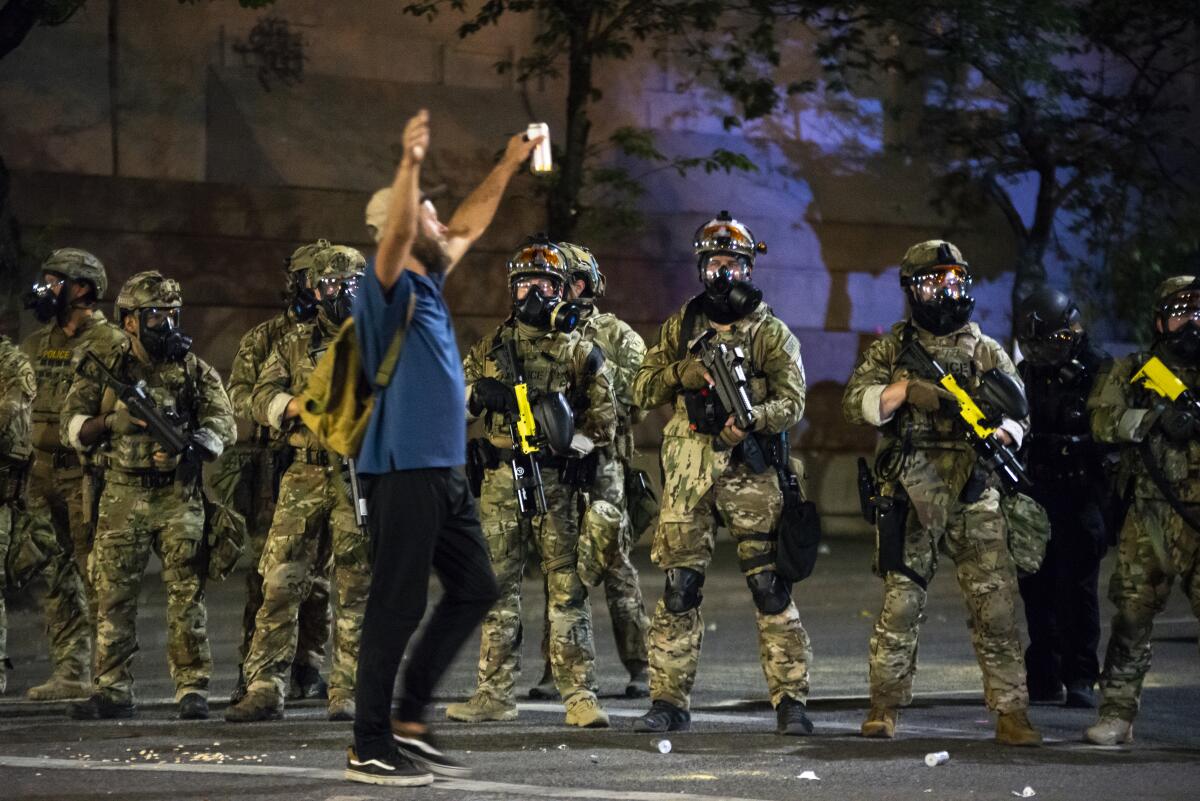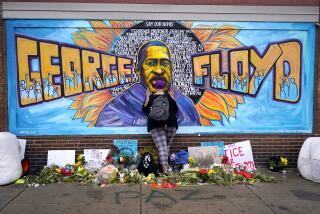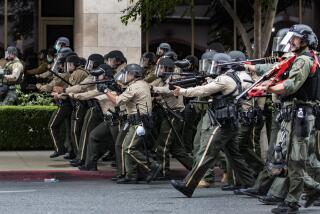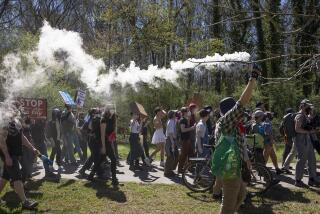A long history of militant activism keeps protests alive in Portland

PORTLAND, Ore. — It has become a dangerous nightly ritual in Portland.
Around 11 p.m., protesters set fire to trash cans or toss burning cardboard into police buildings and hurl bottles, eggs and chunks of concrete at officers.
Then police broadcast an order for the demonstrators to leave.
Most do. But a hardcore group, sometimes numbering in the hundreds, remain to face off against police, who use tear gas, rubber bullets, flash grenades and arrests to clear the streets.
Three months after the death of George Floyd at the hands of Minneapolis police, the nationwide Black Lives Matter demonstrations it sparked have died down — except in Portland.
Keeping the protests alive here is a local brand of activism with a long history. Its adherents support the goals of ending police brutality and racism but their larger purpose is to dismantle what they see as an increasingly authoritarian government that suppresses the rights of citizens. Police, to them, are the front lines of the enemy.
As of last week, protesters had set 41 fires, thrown projectiles at police officers on at least 58 nights and vandalized property on 49 nights, according to the police department, which has declared riots 17 times.
The protesters, who are largely white, defend the nightly taunting of police, along with vandalism and destruction of property, as a strategy to draw officers into clashes and expose them as fascists, a term with a potent past that has become a mantra at rallies and online.
“It’s to try to push the line just above what’s acceptable in order to get them to respond to show their abuse of power,” said a Portland music producer who carries a plastic shield and walkie-talkie to patrol the edge of the demonstrations and keep out far-right extremists.
“I hope this is a revolution,” he said. “And I hope it continues.”
Like many protesters, he expressed concern about being targeted by authorities and spoke on the condition that their names not be published.
Within the Black Lives Matter movement, many activists say that the continuing unrest has been essential for keeping the aim of racial justice in the spotlight.
But some Black Portlanders fear those clashing with police may be drawing negative attention to demands for racial justice.
“It’s been pushed to the side,” said Darrell Millner, an emeritus professor of Black studies at Portland State University. “I think what has happened is that some people have lost an understanding of Malcolm X’s quote ‘by any means necessary’ ... We have to remember that ‘means’ do matter.”
Militant protest in the name of racial justice has deep roots in Portland.
It dates back to the 1970s, when leaders of the hate group Aryan Nation and other organizations dedicated to creating a white ethno-state began encouraging their supporters to move to Washington, Oregon and Idaho.
Racist skinhead groups became a growing presence in Portland over the next decade, making the city an increasingly dangerous place for Black people.
In 1988, after three skinheads beat an Ethiopian student — Mulegata Seraw — outside his apartment, activists began to fight back.
Many of them came from the city’s heavy metal and punk scene — skinheads with a different mission.
“There was a lot of organizing between the Black community and white allies after the murder of Mulegata,” said Walidah Imarisha, a Black historian and activist who lives in Portland.
Newly formed groups such as Skinheads Against Racial Prejudice and the Coalition for Human Dignity began tracking neo-Nazis and white supremacists and outing them to co-workers and police.
They also believed that sometimes violence must be met with violence and engaged in brawls with far-right extremists.
“There was some direct confrontation at protests and rallies,” Imarisha said.
The activists also found common cause with Black residents in calling for accountability for police who killed unarmed Black men or engaged in other mistreatment.
By the early 2000s, some of the activists began saying they subscribed to an ideology known as “antifa,” short for anti-fascist. The name is derived from an organization called Antifaschistische Aktion founded during the 1930s in Germany to oppose the rise of Nazism.
Their basic philosophy is that all forms of fascism must be resisted, though the definition of fascism was open to interpretation.
For a time, it seemed like the activists were winning. Far-right groups stopped holding rallies and largely disappeared from public view.
In fact, they had moved their campaign online, where they could shield their identities and reach more potential recruits, according to Stanislav Vysotsky, a sociologist and criminologist at the University of Wisconsin-Whitewater who has studied the activist movement.
The activists responded with increasing sophistication, infiltrating online groups and chat rooms to expose the extremists.
The election of President Trump in 2016 gave the activists a renewed sense of purpose and brought the conflict back into the open.
White supremacists saw the president as an ally — even if he denied it — and began staging rallies again, often targeting liberal cities. The activists pushed back with their own demonstrations. Clashes were common.
In Portland, police often stepped into the middle, arresting protesters and deploying tear gas and rubber bullets to break up rowdy crowds — and in the process deepened long-standing resentment from the left.
Increasingly, the activists came to believe that their fascist and racist enemies included not only white supremacist groups but also police departments and other government institutions.
That lesson was reinforced in the summer of 2017, when a white supremacist was accused of killing two men on a train in Portland who were defending teenagers from racist taunts.
In an effort to cool tensions, Mayor Ted Wheeler asked the federal government to revoke a permit it had granted for a pro-Trump rally at a federal plaza.
His request was denied, and as the mayor had feared, clashes erupted.
When activists on the left tried to stage their own rally nearby, police declared it an unlawful assembly —confirmation to many that the system itself was morally corrupt and beyond repair.
The May 25 death of Floyd in Minneapolis brought tensions between activists and authorities to a new level, especially after Trump deployed federal agents to the city.
In early July, thousands of people took to the streets after a federal agent shot a rubber bullet and badly wounded an unarmed protester in the head.
Such incidents played into the hands of the hard-line activists.
“When all this started, I considered myself a liberal,” said Emily Gansberg, a 28-year-old grocery store worker who lives in Portland. “And then it kept going further left. My level of dedication became high in a short amount of time.”
“I now call myself baby antifa,” she said.
She said she would not engage in violence herself but believed it was justified because “peaceful protests aren’t going to get anything done.”
“The system is built to oppress,” she said. “And when I say this system, I’m not just talking about the police. I’m talking about the government all the way through.”
Davis Beeman long considered himself an antifa activist, though when the recent protests began he felt uncomfortable with calls to abolish the city’s police.
The 38-year-old cybersecurity expert, who attends protests to deliver first aid to demonstrators, said witnessing the police and federal agents’ use of force and crowd-control munitions to disperse protesters over the last two months has changed his views.
“As I’ve gotten to know more and more history about the Portland police and its overt racism, and how out of touch the police is with the community, I’m on board with getting rid of the police department and starting over,” he said.
Such sentiments were reaffirmed Saturday, when more than 100 white supremacists and other far-right extremists staged a “Back the Blue” rally in support of the police.
Leftist activists showed up and the two sides brawled for two hours, shooting fireworks, paintballs and other projectiles at each other.
The police did not intervene.
In a statement, the department acknowledged that the unrest met the criteria of a riot, but said officers did not move to stop the violence because they were already stretched thin.
Officers “have been the focus of over 80 days of violent actions directed at the police, which is a major consideration for determining if police resources are necessary to interject between two groups with individuals who appear to be willingly engaging in physical confrontations for short durations.”
More to Read
Sign up for Essential California
The most important California stories and recommendations in your inbox every morning.
You may occasionally receive promotional content from the Los Angeles Times.










